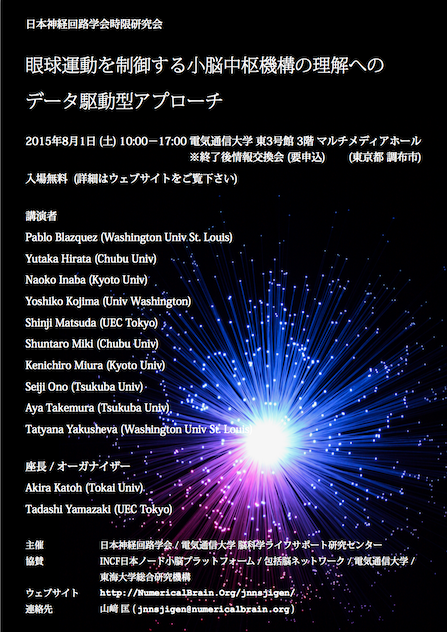September 2015 Issue
News and Events
UEC hosts Japanese Neural Network Society Workshop on "Data-driven approach for understanding cerebellar mechanisms on eye movement control"
Organizers Tadashi Yamazaki, University of Electro-Communications in Tokyo , and Akira Katoh, Tokai University.

On 1 August 2015, a full day workshop on "data-driven approach for understanding cerebellar mechanisms on eye movement control" was held at UEC, Tokyo. The workshop was organized by Tadashi Yamazaki (assistant professor, UEC, Tokyo) and Akira Katoh (associate professor, Tokai University) and jointly sponsored by the Japanese Neural Network Society (JNNS) and Brain Science Inspired Life Support Research Center, UEC, Tokyo.
The workshop consisted of 10 speakers, most of whom were recently promoted to principle investigators at their research institutes. In planning the workshop, the organizers endeavored to maintain a good balance of speakers from Japan and overseas, and male and female representation. The final program consisted of three speakers from the USA and the remainder from Japan, where four of the talks were given by female participants. In spite of the combination of a highly technical program, the holiday season, and hot and humid weather, more than 30 scientists participated in the workshop. The presentations and resulting heated discussions were held in English, and the workshop was successful in achieving its aims.
In cerebellar research, Marr (1969) and Albus (1970) proposed so-called "perceptron hypothesis" that regards the cerebellum as a pattern recognition device via supervised learning. Ten years later, Ito et al. (1982) discovered long-term depression, which was the memory mechanism within the cerebellum and was the missing piece of the Marr-Albus model.
Since then, the Marr-Albus-Ito model has influenced successive cerebellar research while acting as a compass that points to the correct direction of research and way of thinking about the system. Hence, we often say, "cerebellar research is hypothesis driven".
However, where did the hypothesis come from? Of course, it came from data, specifically anatomical and morphological data of cat's cerebellum obtained in the 1950s to 1960s. In those days, a very detailed wiring diagram, or "blue print" of the cerebellum was already available. That is, detailed data allowed scientists to build a good hypothesis. In other words, "no data, no theory". Meanwhile, a data-driven approach has become popular in brain research, where scientists try to extract latent meanings or relationships behind the massive amounts of data. Therefore, in the workshop, we focused on "data".
The workshop included presentations on the cerebellum and eye movement control in primates. Recently, it has been difficult to conduct primate research, so the participants had the privilege to see the latest and detailed data in primate research. The data presented at the workshop ranged from microscopic level (molecular biology), mesoscopic level (electrophysiology) and macroscopic level (system / behavioral level), underscoring the very comprehensive nature of the workshop in covering research on cerebellum and eye movement control.
Notably, Dr. Shinji Matsuda from UEC, Tokyo presented his technique to control long-term depression by light. This technique will provide the final means to elucidate the causal relationship between long-term depression and cerebellar motor learning.
In summary, the workshop was very successful. The organizers would like to have this kind of workshop on a regular basis to promote brain science at UEC, Tokyo and cerebellar research in Japan.
Finally, the organizers are grateful for the generous financial support from the following organizations: International Neuroinformatics Coordinating Facility (INCF) Japan Node Cerebellar Platform; Comprehensive Brain Science Network; Tokai University Educational System General Research Organization; and The University of Electro-Communications.
Further information
- Workshop website: http://numericalbrain.org/jnnsjigen/index.en.html
- Speakers and titles of talks
- Kenichiro Miura (Kyoto Univ)
- Visual control of eye movements in mice: the optokinetic response
- Shuntaro Miki (Chubu Univ)
- Cerebellar dependent predictive optokinetic response associated with oculomotor velocity storage mechanism in goldfish, carp, zebrafish, medaka, and human
- Naoko Inaba (Kyoto Univ)
- The role of the cortical areas MT and MST in coding of visual motion during pursuit eye movements
- Pablo M Blazquez (Washington Univ St. Louis)
- Thinking inside the box. Signal processing by cerebellar cortex interneurons in the macaque ventralparaflocculus
- Tatyana Yakusheva (Washington Univ St. Louis)
- Role of GABAergic inhibition in the vestibular signal transformation carried out by the cerebellar nodulus and uvula
- Aya Takemura (AIST)
- Neural activity in monkey's cortical area MST Represents Retinal Error during Motor Learning
- Yoshiko Kojima (Univ Washington)
- Substantia nigra pars reticulata influences the error signals for the saccade adaptation
- Shinji Matsuda (UEC, Tokyo)
- Understanding and controlling synaptic plasticity
- Seiji Ono (Tsukuba Univ)
- Role of visual velocity and position error signals in smooth pursuit adaptation
- Yutaka Hirata (Chubu Univ)
- Promoted motor learning of oculomotor velocity to position neural integrator under hyper-gravity and brighter visual stimulation


